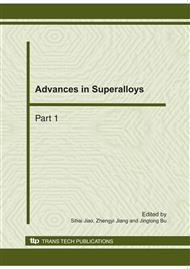p.281
p.288
p.293
p.297
p.301
p.306
p.310
p.314
p.318
Analysis of Carbide Precipitates in API X80 Medium-Thickness Plate
Abstract:
In order to discuss the abnormal fracture in drop weight tear test (DWTT) of API X80 medium-thickness plate, some unqualified samples in DWTT are characterized by SEM, AES, electrolysis and thermal simulation. SEM results show that there are many spherical precipitates in the fracture surface. EDS and AES results show that the abnormal spherical precipitates are carbides including Fe, Ni, Mo, Ti, etc. These precipitates can be extracted by neutral electrolyte method and their EDS results further demonstrate they are carbides. The formationmechanismof the precipitates is discussed based on thermal simulation experiments. When the cooling rate of medium-thickness plate is not enough high, especially in carbide formation area in Fe-C diagram, abnormal spherical carbides will occur and they are harmful for DWTT.
Info:
Periodical:
Pages:
301-305
Citation:
Online since:
October 2010
Authors:
Keywords:
Price:
Сopyright:
© 2011 Trans Tech Publications Ltd. All Rights Reserved
Share:
Citation:


